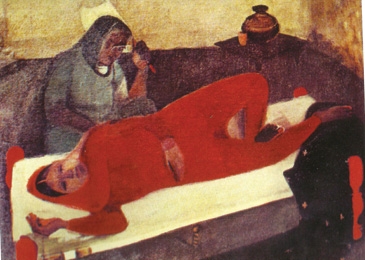
Feature: Amrita an enigma – 4
 By Amit Srivastava
By Amit Srivastava
The well known painting ‘Three Girls’ (1935) is a masterpiece of art. The melancholic work was the first painting done by Amrita Sher-Gil after coming back from Paris in 1934. The three girls wear flamboyant clothes and are on the verge of adulthood and marriage. But alone in their isolated brooding expressions.

The vibrant colours of their clothing – reds, greens and amber contrasts against the quiet grim brown faces.. All the three girls here wear quiet and passive expressions. There is a pall of despondency on their faces as if they are waiting for someone but seem to have braced up for the sadness and hopelessness of the wait. The painting got Amrita a gold medal from the Bombay Arts Society in 1937.

Earlier her painting “ Young Girls” done during the Paris days, was the recipient of the gold medal at the Paris Salon, the prestigious art show. The painting depicts young women seated and in conversation with each other. Her sister Indira and a friend Denise, were the models for this work. The posture of Indira is upright and confident while the Denise has her face and her half undressed body obscured by her hair. In this painting the strict upright posture of Indira is matched by the abandon of the fair haired women, with her bare breast partially covered by her hair. For Amrita, the strong individuality of women seeking bonding with each other became a recurrent motif in her paintings.

The motif of dark women existing in equation with a white women with all the poise and confidence is a theme that was to reach its apogee in a painting known as ‘ Two Girls’. The subtle influence of Paul Gaugin and Paul Cezanne is sometimes visible in Amrita’s work. In this painting also, the spatial tilt, that reminds us of Cezanne, leads to a certain lopsidedness in the equation between the two girls who are having a conversation. This is evident by the slouching stance of the blond girl with her face covered by hair, who seems to be ill at ease with the privileged world in which she exists. Experts are of the opinion that the two girls perhaps, represent the two facets of Amrita’s own personality. Amrita’s mixed heritage and her strikingly good looks straddled many worlds both literally and metaphorically. This painting of hers portrays her own conflicting desires and a confrontation between her two worlds east and west, light and dark, attraction and restraint.

‘Brahmcharis‘ is one of the most celebrated works of Amrita. The painting has five male squatting male figures. It has red background and the painting stresses the subtle nuances of form as it contrasts against the white of the dhotis. Although each one is different, there is a semblance of uniformity somehow. This masterpiece displays a simplicity where colour and form counter pose each other. . There is exemplary balance of tensions. The whites offset and balance the brown of the bodies and the red of background.
Amrita’s study of Mughal miniatures had started showing in the refinement of her work. She had achieved a great economy of lines during her last phase when she did ‘ Woman in Charpoy’. This is a portrait of a woman who is stifled with emotion yet pregnant with possibilities.

‘Woman in Charpoy’ – This painting was one of the last ones by Amrita. He flaming red of her clothes and of bedposts creates an ambience of eroticism just like miniatures. She describes this painting in her own words –
“I have just finished a picture- a girl in red flowered clothes is reclining in a charpoy, its post of an incandescent red rose round her like tongues of flame, a fat dark woman in green is fanning her ( muddy, blackish, brown tones in the flesh very attractive) the wall behind is a warm darkish transparent yellow, the charpoy itself is a yellowish off white. There is dark blue drapery on it that sweeps the ground embroidered with little magenta and cream coloured flowers.”
– (to conclude)





